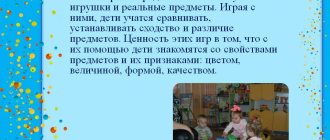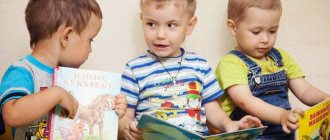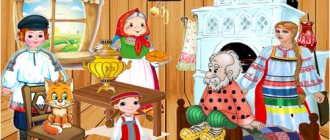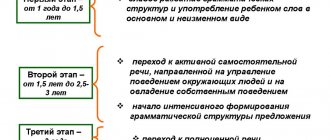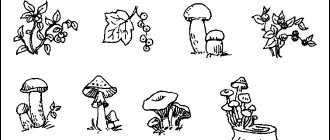- home
- Speech development
By the end of preschool childhood, the formation of sound culture ends; the pronunciation of a future first-grader should be just like that of an adult. But the development of speech of a 6-7 year old child continues if parents and teachers create the necessary conditions for this. The period of preparation for school should be accompanied by an increase in active vocabulary, training in the use of correct grammatical structures and complex sentences, and the development of the ability to reason. These qualities are the key to successful learning at school, so it is necessary to carry out speech therapy work with the child even if he already pronounces all the sounds correctly. Exercises and tasks for speech development for preschoolers 6-7 years old can be printed and used as an option for home preparation for school.
Features of speech development 5 – 6 years old
All components of speech at this age are improved, because they are necessary for further school education.
Phonetics: pronunciation of sounds
A 5-year-old child is ready to pronounce all sounds correctly. But some children still cannot master sibilants and “r” (it is replaced with “l”). Moreover, in isolation they can pronounce “r” correctly, but not in words. Even those elements that they always say correctly can “limp” in words with a complex syllable structure.
A characteristic feature of the speech development of a 5-year-old child is that he notices how his friends speak and his own mistakes, that is, he becomes critical.
Vocabulary of preschoolers
It is between 2,500 and 3,000 words. The dictionary is supplemented with generalizing words.
Another feature of speech development at 5–6 years old is that children operate with many concepts. They can name natural phenomena, household items, seasons, professions, types of transport, animals (domestic and wild), birds, fruits and vegetables.
Moreover, they have an idea about, for example, how fruits and vegetables are grown, what changes occur during different seasons, about which animals live in the forest and which on the farm. They orient themselves in space, know the names of months, days of the week, holidays, and traffic rules for pedestrians.
They like to talk about what they see and what is happening. Communication contributes to the development of speech, and vice versa.
They speak simple words correctly, do not change or skip syllables. But complex or unfamiliar words can be distorted.
Grammatical structure of speech
In most cases, children speak in common simple sentences, but complex ones appear. Sentences become more grammatically formed - they contain the main parts of speech.
Collective nouns appear (children, linen, foliage), adjectives that denote the properties and state of things (icy, frozen). Abstract concepts (heartfelt, sweet, kind) are accessible to children.
The following features of speech development are identified at the age of 5–6 years: children correctly use prepositions, conjugate nouns according to cases and numbers, coordinate nouns with numerals (three bullfinches, five chocolates), form possessive adjectives (mother’s, fox).
Children may incorrectly use nouns in the nominative, genitive cases in the plural (pencil - many pencils) and prefixes with spatial meaning (came up, came in, entered). This is considered normal for speech development at this age.
Speech coherence
Preschoolers speak quite coherently, consistently and logically. They can make up a story based on a picture or a series of illustrations, or retell a short story or fairy tale of 50 sentences. They can conduct a monologue and operate with phrases. They have sufficiently developed speech skills to accurately express their thoughts, desires, and share their impressions.
Normal speech development in a 6-year-old child
The following features are characteristic at this age:
- The vocabulary includes up to 3000 words, they are memorized on the fly;
- Children pronounce all sounds;
- The articulatory apparatus is fully formed;
- Word creation is “dying away”;
- They know how to control their voice - tone, volume;
- A simple sound analysis is available: they can find a sound in a word and select words that begin with it;
- They operate with generalizing words, different categories (dishes, transport, seasons, wildlife);
- Development of coherent speech 5 – 6 years.
Engage with your child. Talk a lot, conduct a dialogue, answer questions, read and discuss books, films - all this contributes to the development of speech. Exercises you can do at home are effective.
Article:
Work continues with older preschoolers to enrich, clarify and activate the vocabulary.
Much attention is paid to the development of children’s skills to generalize, compare, and contrast. Words denoting the material from which an object is made (“wood”, “metal”, “plastic”) are introduced into the dictionary; riddles and descriptions of objects, their properties, qualities and actions are widely used. Particular attention is paid to working on the semantic side of a word, expanding the stock of synonyms and antonyms, polysemantic words, and developing the ability to use words that most accurately suit the situation. "What do you see around you?" Goal: to clarify children’s ideas about the names of objects. - Name the objects that you see around. How do we distinguish one object from another? (They sit at the table, study, eat, sit on a chair.) - If two girls stand in front of you, both in red dresses, with white bows. How do we differentiate them? (By name.) - What do the words... “ball”, “doll”, “pen” mean? - I have... a pen in my hand. What are they doing with it? (They write.) The door also has a handle. Why are these objects called by the same word? (They are held with their hands.) What does the word “handle” mean, denoting this object? (They write with it.) What does the word “handle” mean (point to the door handle)? (“They open and close the door with it.”) - Can you name words that don’t mean anything? Listen to Irina Tokmakova’s poem “Plim”: A spoon is a spoon. And I came up with a word. The soup is eaten with a spoon. A funny word is plim. A cat is a cat. I repeat again - The cat has seven kittens. Plim, plim, plim. A rag is a rag. Here he jumps and jumps - I’ll wipe the table with a rag. Plim, plim, plim. A hat is a hat. And it doesn’t mean anything. I got dressed and went. Plim, plim, plim. - Come up with words that don’t mean anything (tram-tatam, tuturu). Working with synonyms helps children understand the ability to select different words with similar meanings and develop the ability to use them in their speech. By selecting words that are close in meaning to the phrase (cheerful boy - joyful; the train is coming - moving; Masha and Sasha - children, friends), to a certain situation (at a birthday party they are having fun, rejoicing), to an isolated word (smart - sensible; old - dilapidated), children learn the accuracy of word usage, depending on the context. By composing sentences with words of a synonymous series, denoting an increase in actions (whispers, speaks, screams), children become aware of the nuances of the meanings of verbs. GAMES AND EXERCISES ON SPEECH DEVELOPMENT FOR CHILDREN OF SENIOR PRESCHOOL AGE (6 - 7 YEARS OLD)
“Say which” Purpose: name the signs of an object and action; enrich speech with adjectives and verbs; select words that are close in meaning. — When we want to talk about a subject, what is it like, what words do we use? - Listen to M. Shchelovanova’s poem “Morning”: - Listen to M. Shchelovanova’s poem “Morning”. What is it like this morning? It's a bad morning, It's a boring morning, And it looks like it's going to rain. - Why is it a bad morning? Today is a good morning, Today is a cheerful morning and the clouds are moving away. Today there will be no sun, Today there will be no sun, Today will be a gloomy, Gray, cloudy day. - Why won’t there be sun? There will probably be sun, There will definitely be sun and a cool blue shadow. -What is this poem talking about? (About a sunny and cloudy morning.) As it is said about the first day in the poem, what is it like? (Gloomy, gray.) How can I say in other words about this day? Choose words that are close in meaning (rainy, sad, boring, unfriendly). And if the morning is sunny, how else can you say what it is like? Choose words that are close in meaning (cheerful, joyful, blue, cloudless). What else could be gloomy? (Mood, weather, sky, person.) What can be sunny? — There are also words that describe what a person does, what can be done with this or that object. If a person frowns, how can you say it differently? (Sad, sad, upset, offended.) - And there are words and expressions that do not express the meaning entirely accurately. I heard other children say: “Dad, go in a whisper,” “I woke up my sister,” “I put my shoes on inside out.” Is it possible to say that? How should I say it correctly? “Find the exact word” Purpose: to teach children to accurately name an object, its qualities and actions.
- Find out what object I’m talking about: “Round, sweet, ruddy - what is it?” Items may differ from each other not only in taste, but also in size, color, and shape. - Complete with other words what I start: snow is white, cold... (what else?). Sugar is sweet, and lemon... (sour). In spring the weather is warm, and in winter... (cold). - Name what things in the room are round, tall, low. - Remember which of the animals moves how. A crow... (flies), a fish... (swims), a grasshopper... (jumps), a snake... (crawls). Which animal makes its voice? Rooster... (crows), tiger... (roars), mouse... (squeaks), cow... (moos). - Help me find words that are opposite in meaning in D. Ciardi’s poem “The Farewell Game”: I will say the word high, And you will answer... (low) I will say the word far away, And you will answer... (close). I will tell you the word coward, You will answer... (brave). Now I'll tell you the beginning. Well, answer... (end). - Now you can come up with words that have opposite meanings. Older preschoolers can distinguish words that reflect the nature of the movement (run - rush; came - trudged) or the meaning of adjectives of an evaluative nature (smart - judicious; old - decrepit; timid - cowardly). An important place in the development of vocabulary is occupied by work on antonyms, as a result of which children learn to compare objects and phenomena according to temporal and spatial relationships (by size, color, weight, quality). They select words that are opposite in meaning to phrases (old house - new, old man - young), to isolated words (light - heavy), or finish the sentence started by the teacher: “One loses, the other ... (finds).” “High - low” Purpose: to learn to compare objects and find words that have opposite meanings. For this game you need to select pictures: a tall Christmas tree, a long pencil, a wide ribbon, a deep plate of soup, a cheerful face of a girl (laughing or smiling), a boy in dirty clothes, and also: a small Christmas tree, a short pencil, a narrow ribbon, a sad face of a girl , boy in clean clothes, small plate (Fig. 5). - Look at the pictures. Name words that have opposite meanings. Tell me how similar faces and objects differ. High - low (Christmas tree - Christmas tree), long - short (pencil), wide - narrow (ribbon), sad - cheerful (girl's face),
deep - shallow (plate), clean - dirty (boy). In the following picture: a big house and a small house, a river - a stream, a strawberry - a strawberry. - Tell me what you see in these drawings? Make up sentences with words that have opposite meanings. (“I drew a big house and a small house.” “The river is deep, but the stream is shallow.” “Strawberries are large, but wild strawberries are small.”) - Listen to an excerpt from Silva Kaputikyan’s poem “Masha is having lunch”: ... There is no refusal to anyone, Lunch was served to everyone: For the dog - in a bowl, In a saucer - for a pussy, For a laying hen - Millet in a skull, And for Mashenka - in a plate, In a deep one, not in a shallow one. - What is deep and shallow? How do you understand the expression: deep river (has great depth); deep secret (hidden); deep feeling (strong); shallow river (has a small depth); light rain (not heavy); fine sand (medium-sized). “Is this true or not?” Goal: find inaccuracies in the poetic text. — Listen to L. Stanchev’s poem “Is this true or not?” You have to listen carefully, then you can notice what doesn’t happen in the world. It's a warm spring now, the grapes are ripe here. A horned horse jumps in the snow in the summer meadow. In late autumn the bear likes to sit in the river. And in winter, among the branches, “Ha-ha-ha!” - the nightingale sang. - Quickly give me an answer: is this true or not? - Listen to what the other children said, think if it’s possible to say this, and tell me how to say it correctly: “Auntie, look: the horse has two tails - one on its head, the other on its back”; “Daddy, this is the horse’s soles being beaten”; “Dad, they recently sawed wood here: there are sawmills lying around in the snow”; “I opened my eyes a little and looked in a whisper”; “Mommy, I love you loudly and loudly.” - Can you come up with tall tales or confusions so that other children or adults can unravel them? “Find another word” Purpose: to accurately indicate the situation; select synonyms and antonyms. — Dad decided to make a swing for the children, Misha brought him a rope. “No, this rope is no good, it will break.” Misha brought him another one. “But this one will never break.” What rope did Misha bring first? (Thin, shabby.) And then? (Strong, durable.) - Dad made the swing in the summer. But then... winter came. Misha grew up as a strong boy (healthy, strong).
He went out to skate and felt strong ice under his feet. How can I say it differently? (Durable, non-fragile.) The frost grew stronger (became stronger). — How do you understand the expression “a tough nut to crack”? (It is difficult to break, to break.) This is what they say not only about nuts, but also about people whom no adversity can break. They say about them: “strong in spirit” (meaning a strong, persistent person). — Explain what the words mean: “strong fabric” (durable), “sound sleep” (deep), “strong tea” (very strong, not diluted with boiling water). What expressions with the word “strong” have you come across in fairy tales and which ones? (In the fairy tale “The Little Goats and the Wolf,” the goat firmly (very strictly) ordered the children to lock the door tightly (very tightly).) - Come up with sentences with the word “strong.” “I will tell you words, and you tell me words with the opposite meaning: long, deep, soft, light, thin, thick, strong; talk, make laugh, fall, laugh, run. - Come up with a story so that it contains words that have opposite meanings. You can take the words that we just mentioned. “Name it in one word” Goal: find words that accurately assess the situation. — The student was solving a problem and could not solve it. He thought for a long time, but still solved it! What task did he get? (Difficult, difficult, difficult.) Which of these words is most accurate? (Difficult.) What are we talking about heavy, heavy, heavy? Replace the expressions: heavy load (having a lot of weight), heavy sleep (restless), heavy air (unpleasant), severe wound (dangerous, serious), heavy feeling (painful, sorrowful), difficult to climb (difficult to decide on something) ), severe punishment (severe). — How do you understand the expressions “difficult job” (it requires a lot of work), “difficult day” (not easy), “difficult child” (difficult to educate). What other expressions with this word have you heard? — Listen to E. Serova’s poem “Give me a word.” You will tell me the right words. The verse flowed smoothly, smoothly, I say to my brother: “Oh! Suddenly he stumbled and fell silent. Peas are falling from the sky!” He waits and sighs: “What an eccentric,” the brother laughs, “Words are not enough.” Your peas are... (hail).” So that we can be on our way again, from whom, my friends, does the verse flow like a river, and is there no way to escape? Help him a little, persistently on a clear day, say a word. Walking next to us... (shadow). - Come up with a story so that it contains the following words: “big”, “huge”, “huge”; “small”, “tiny”, “tiny”; “runs”, “rushes”, “rushes”; “walks”, “travels”, “drags”. By developing children’s understanding of the meanings of polysemantic words of different parts of speech (“lightning”, “faucet”,
"sheet"; “to pour”, “to float”; “full”, “sharp”, “heavy”), we teach them to combine words according to their meaning in accordance with the context. Older preschoolers continue to be taught those grammatical forms that they find difficult to master: agreement of adjectives and nouns (especially in the neuter gender), the formation of difficult verb forms (in the imperative and subjunctive mood). It is necessary to give the child complete orientation in the typical ways of inflection and word formation, to cultivate a sense of language, an attentive attitude to the language, its grammatical structure, a critical attitude towards one’s own and others’ speech, and the desire to speak correctly. Children develop the ability to select a word-forming pair from a number of words (those words that have a common part - “teaches”, “book”, “pen”, “teacher”; “story”, “interesting”, “tell”) or form model word: cheerful - fun; quickly... (fast), loud... (loud). Children find related words in context. For example, with the word “yellow”: “There are (yellow) flowers growing in the garden. The grass begins to... (turn yellow) in the fall. The leaves on the trees... (turn yellow).” Children develop the ability to form nouns with augmentative, diminutive, affectionate suffixes and understand the difference in the semantic shades of the word: birch - birch - birch; book - little book - little book. Distinguishing the semantic shades of verbs (ran - ran - ran up) and adjectives (smart - smartest, bad - inferior, complete - plump) develops the ability to accurately and appropriately use these words in different types of statements. “Who has whom” Goal: correlate the names of animals and their cubs, select actions to match the names of the animals. The child looks at the drawings - animals with babies: a hen and chick are pecking grains (or drinking water), a cat and kitten are lapping milk (option - playing with a ball), a dog and puppy are gnawing on a bone (option - barking), a cow and calf are nibbling grass (option - moo), a horse and a foal chew hay (option: they jump), a duck and a duckling swim (quack). - Name the animals and their young. - Choose definitions for the names of baby animals: tell me which chicken (cat, dog, cow, duck, horse), which chicken (kitten, puppy, calf, foal, duckling)? “One - many” Purpose: to practice the formation of the plural and the correct use of words in the genitive case; match words with definitions and actions; find the first sound in words, determine the number of syllables, select words that sound similar.
- This is a ball, and these are... (balls). There are a lot of... (balls). What balls? (Red, blue, green.) How can you say in one word that all the balls are different colors? (Multi-colored.) - This is a poppy, and this is... (poppies). There are a lot of... (poppies) in the bouquet. What are they? (Red.) What else is red? How do you understand the expression “red maiden”? Where does this expression occur? In what fairy tales? - Guess the riddle: “Grandfather is sitting, wearing a hundred fur coats. Whoever undresses him sheds tears.” This is... (bow). What is he like? (Yellow, juicy, bitter, healthy.) Is there a lot of stuff in the basket? (Luke.) - What is this? What is there a lot here? - And if all the objects disappear, how will we say what is missing? (Needles, saws, bears, mice, cones, spoons, legs, cats.) Particular attention is paid to the syntactic side of speech - the ability to construct not only simple common, but also complex sentences of various types. To do this, exercises are carried out to distribute and supplement the sentences started by the teacher (“The children went into the forest so that... They ended up where...”). The formation of the syntactic side of children's speech and various syntactic structures is necessary for the development of coherent speech. In retelling literary works (fairy tales or short stories), children learn to coherently, consistently and expressively convey the finished text without the help of an adult, intonationally conveying the dialogue of the characters and the characteristics of the characters. In telling a story based on a picture, the ability to independently compose a descriptive or narrative story based on its content involves indicating the place and time of action, inventing events preceding and following what is depicted. Storytelling through a series of plot pictures develops in children the ability to develop a plot line, come up with a title for the story in accordance with the content, and connect individual sentences and parts of statements into a narrative text. When talking about toys (or a set of toys), children are taught to compose stories and fairy tales, observing the composition and expressive presentation of the text. When choosing appropriate characters to tell, children give their descriptions and characteristics. With children of senior preschool age, learning to tell stories from personal experience continues, and these can be statements of different types - descriptions, narratives, reasoning. “Make a description” Purpose: to teach children to describe an object, naming its characteristics, qualities, actions. - Describe the berry or fruit that you love most, and we will guess. (“It’s round, red, juicy, delicious - it’s my favorite... tomato”; “It’s dark burgundy in color, and inside it has many, many different grains, sweet and ripe, this is my favorite fruit... pomegranate.”) Let's give an example. classes where all speech tasks are closely intertwined: education of sound
speech culture, vocabulary work, formation of grammatical structure of speech and development of coherent speech. “Come up with a story” Goal: to teach children to understand the figurative meaning of words and expressions, which change their meaning depending on phrases, and to transfer them into a coherent statement. - Finish the phrase: 1. The pillow is soft, and the bench... (hard). Plasticine is soft, and stone... (hard). 2. The stream is shallow, and the river... (deep). Currant berries are small, and strawberries... (large). 3. The porridge is cooked thick, and the soup... (thin). The forest is thick, and sometimes... (sparse). 4. After rain, the ground is damp, but in sunny weather... (dry). We buy raw potatoes and eat... (boiled). 5. We bought fresh bread, but the next day it became... (stale). In the summer we ate fresh cucumbers, and in the winter... (salted). Now the collar is fresh, but tomorrow it will be... (dirty). - Explain how you understand these expressions: the rain was mischievous; the forest is dormant; the house is growing; streams are running; the song flows. — How to say it differently: evil winter (very cold); prickly wind (harsh); light breeze (cool); golden hands (they can do everything beautifully); golden hair (beautiful, shiny)? — Where have you come across the expression “evil winter”? (In fairy tales.) Who does the word “evil” refer to? (Evil stepmother, evil witch, evil Baba Yaga.) - Come up with a coherent ending to the phrases: “Little bear, where did you walk? (I was looking for honey on the tree.) Little bears, where have you been? (We walked through the raspberries into the forest, we wandered in the clearing.) The little bear was looking for honey (and lost his little brother).” - Come up with a story about two bear cubs, and I’ll write it down, then we’ll read it to dad (grandmother, sister). “Say more precisely” Goal: to develop accuracy of word use in coherent narrative stories. - Listen to what I tell you. Where I stay, you will help me: select words and compose sentences.
Once upon a time there were three brothers: the wind, the breeze and the wind. The wind says: “I am the most important!” What kind of wind could it be? (Strong, sharp, impetuous, cold...) Vetrishche did not agree with his brother: “No, I’m the most important, my name is Vetrishche!” What kind of wind? (Powerful, angry, harsh, icy.) Little Breeze listened to them and thought: “What am I?” (Light, gentle, pleasant, affectionate...) The brothers argued for a long time, but they never found out anything. They decided to measure their strength. Wind started to blow. What happened? (The trees swayed, the grass bent to the ground.) What did the wind do? (Blowed, rushed, hummed, grumbled.) The wind blew. What was he doing? (Blowed strongly, howled, howled, rushed rapidly.) What happened after that? (The branches of the trees broke, the grass died, clouds rolled in, birds and animals hid.) And then the breeze blew. What was he doing (blowing gently and tenderly, rustling leaves, playing mischief, swaying branches). What happened in nature? (The leaves rustled, the birds began to sing, it became cool and pleasant.) - Come up with a fairy tale about the wind, a little breeze or a breeze. You can talk about all of them at once. Who could they be in a fairy tale? (Brothers, rivals, friends, comrades.) What can they do? (Make friends, measure strength, argue, talk.) All these exercises, games, activities can be repeated so that children learn that words have meaning and can change. They sound different. If the child completes all the tasks correctly, it means that he has a high level of speech development and is well prepared for school.
Speech development games at home
We offer a set of exercises. They are held in the form of a game:
- Days of the week. We name the days of the week, clap our hands - one clap per syllable. Then the parent simply claps, and the children guess the day of the week;
- Let's listen to the words. An adult chooses a topic, for example “Farm”, and 3 words on this topic (cow, carrot, field). Then he makes up a story with these words. The task is to jump every time an adult says one of three words;
- Let's rhyme. An adult chooses any word and comes up with rhymes for it. Then he describes him without naming him. For example, “bicycle” is “what is sent to grandparents in a letter” (“hello”). Preschoolers must guess it;
- If I... The adult comes up with phrases that begin with “If I...”, and the children must complete them. “If I go to bed in my clothes”, “If I don’t eat porridge”, “If I suddenly become big”;
- Apple relay. You will need apples with matches. Matches are stuck into the fruit and given to the baby. He must take out a match, describing the apple: red, plump, round, ripe;
- Part and whole. To play you need a ball. The adult throws it to the baby and names a part of some object (fender, screen, steering wheel). The preschooler must immediately say which thing the part belongs to and throw the ball back;
- Finish the word. You will need a ball. The adult throws it to the child and says the initial syllable of any word. The preschooler’s task is to finish the word by throwing the ball back;
- Opposites. We study antonyms. The parent says the word (sweet, big), and the child says the opposite meaning (sour, small). It's even more interesting to play with the ball;
- A hundred questions. Dad or mom takes several items that are well known to the child. For example, a book, a fork, a banana, a toy. You will also need 50 chips. The game consists of the child asking questions about each thing. They can be the most incredible. For each question the kid gets a chip. You can play alone, but it’s more interesting in a group of several people;
- Nonsense. The parent talks about different consoles - non-, mini-, maxi-, anti-, archi-. You need to make sure that the child understands and remembers everything. Then he names any word, and the preschooler must add a prefix from those listed and talk about what has received a new name. For example, an anti-dog: what it is like, where it lives, what it likes, what it looks like. If several children are playing, the adult “distributes” one console to each one, and then says a word - each participant adds his own console to it.
Both one child and several of his friends (up to 6 people) can take part in the games. The more people, the merrier.
Symptoms of delayed speech development in children 5–6 years old
The diagnosis of speech development delay (SDD) is made if the speech of a 6-year-old child is far behind age norms. Here are the criteria that can be used to assume that a preschooler has speech development disorders:
- Poor vocabulary: less than 2500 words;
- Cannot make up a story from a picture or retell a story;
- Cannot highlight the main thing in a story;
- Insufficient development of coherent speech 5 – 6 years;
- Does not pronounce sounds;
- The voice is slurred, unclear, monotonous, endings are “swallowed”;
- Cannot evaluate the actions of the hero, compare the heroes of a fairy tale, film, cartoon.
If there are speech development disorders in children 5–6 years old, contact a speech pathologist. Don't wait for your baby to speak up on his own - it won't happen. Therefore, consult a speech therapist as soon as possible and begin correction. After all, with speech development disorders, children have a much harder time with the school curriculum, it is difficult for them to socialize, make friends, and self-esteem decreases over time.
Information for parents
Adults are role models and a source of knowledge for children. Therefore, it is important that parents take an active part in children's development and follow all recommendations of teachers.
Self-diagnosis of speech delay
The speech therapist conducts an examination in kindergarten and selects a group of children with whom he will carry out correction. But you shouldn’t wait for your child to sign up for lessons. Parents should be able to independently diagnose his speech development.
- The child is asked to describe the object being shown - a toy or other object.
- The adult describes the object, and the preschooler must name it.
- You need to check the expressiveness of speech: ask to speak sentences with different intonation and pitch of voice.
- The child is shown a picture and asked to describe what is shown in it. If he has any difficulties, the adult asks leading questions. During the story, you need to pay attention to the composition of the sentence, vocabulary and general expressiveness of speech.
- Parents should pay attention to the grammatical design of the sentence: agreement of words, use of conjunctions, particles, prepositions.
- During diagnosis, the formation of sound pronunciation is assessed.
Diagnostic conversation
Important! When inviting a child to complete tasks, an adult should give an example using his own example. For example, he asks a preschooler to name a word and first pronounces it himself.
In older preschool age, some mistakes are normal, because at six years old, not all children immediately absorb a large flow of information. But with the help of didactic games it is possible to cope with speech errors. Such exercises will also be useful for children with normal development.
How to develop speech in a 5 year old child
It is worth purchasing books by the following authors: Gerbova V.V., Kuznetsova E.V., Razumovskaya Yulia, Tikhonova I.A., Ushakova O.S. In their books, parents and teachers will be able to find lesson notes for speech development for 5-6 year olds that meet the requirements of the Federal State Educational Standard.
Specialists speak at parent meetings, where they explain in detail how to perform the exercises correctly and issue memos with detailed recommendations. The main goal of tasks in working with this age category is to develop coherent logical speech and form a grammatical structure.
The following exercises should be included in the file cabinet:
- selection of synonyms and antonyms;
- classification of objects according to one criterion;
- guessing words from descriptions;
- Declension of words by numbers and cases;
- making sentences from words;
- explanation of the meaning of proverbs and sayings;
- memorizing poems;
- performing articulatory gymnastics.
Speech development lesson
Important! When retelling a fairy tale or poem, pay attention to the expressiveness of speech and the clarity of pronunciation of sounds.
Templates of speech therapy characteristics for children of different levels for PMPC
Talking about the world around you while walking has a beneficial effect on speech development; conversation with the child about how his day went and other topics of interest to him.
Educational online games are popular: in this case, adults do not need to prepare visual material and think through the exercise. But you need to ensure that the time spent at the computer does not exceed 10 minutes. It is better to alternate information technologies and oral exercises.
